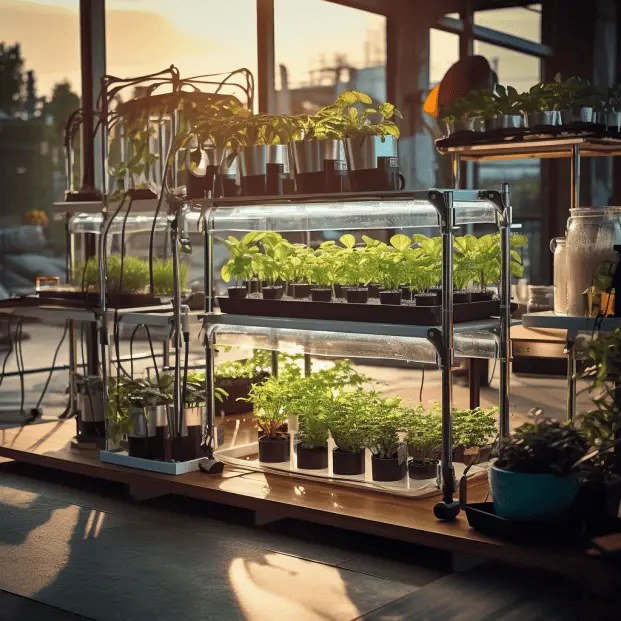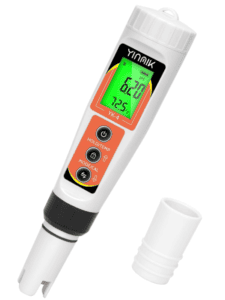According to hydroponics expert Maya Carson, “Overfeeding plants is the number one cause of issues in hydroponic systems.”
Excess nutrients disrupt the delicate balance required for healthy growth.
But with careful monitoring and adjustment, luscious crops can flourish.
The key is recognizing early signs like burnt leaf tips or algae growth.
Test nutrient levels regularly.
Start with lower doses and increase gradually.
Consider each plant’s needs.
With fine-tuned nutrition, hydroponics allows precisely controlled delivery for optimal health.
Hobbyists and commercial growers alike can harness this potential with diligent care.
Achieve bountiful yields through attentive feeding.
Let’s explore key strategies for fertilizing without overdoing it.
KEY TAKEAWAY
What happens if you add too much nutrients to hydroponics?
Adding too much nutrients to hydroponics can lead to nutrient burn, causing visible stress in plants.
To troubleshoot the issue, proper management and awareness of symptoms are crucial for maintaining a healthy hydroponic system.
Nutrient Deficiency Symptoms
When plants lack certain nutrients, they exhibit telltale signs of stress. (1)
Careful observation of leaf color, growth patterns, and plant vigor provide clues to missing elements.
Common deficiency symptoms include stunted growth, discolored leaves, dead leaf tips, and susceptibility to pests.
Chlorosis, or yellowing leaves, often indicates iron, magnesium, or nitrogen deprivation.
Purple leaves may signal phosphorus or potassium deficiencies.
Specific nutrients and associated shortage symptoms:
- Nitrogen: Stunted growth, yellowing older leaves
- Phosphorus: Reddish leaves and stems, weak roots
- Potassium: Chlorosis, burnt leaf edges and tips
- Sulfur: Pale young leaves, overall chlorosis
- Magnesium: Interveinal chlorosis, reddish tints
- Calcium: Dead leaf tips, stunted new growth
- Iron: Interveinal chlorosis, whole plant pale
- Manganese: Interveinal chlorosis, crinkled leaves
- Boron: Death of growing tips, malformed new growth
- Zinc: Rosette leaf formation, discolored leaves
- Copper: Withered tips, curling and yellowing leaves
- Molybdenum: Marginal yellowing or scorching of older leaves
Nutrient Toxicity Symptoms
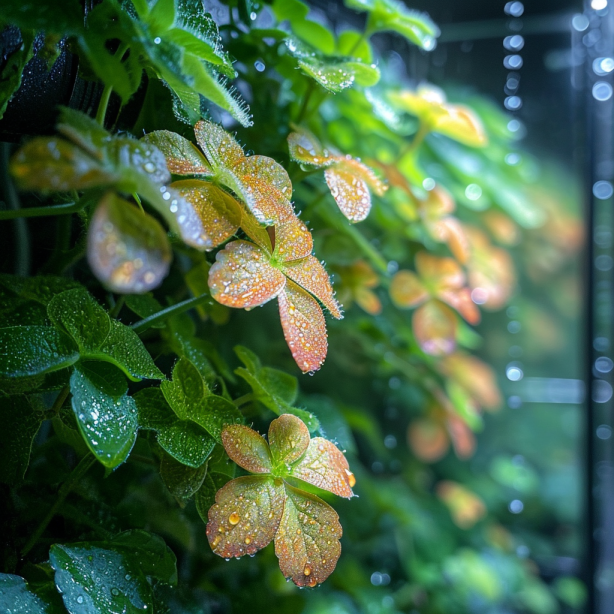
While deficiencies hinder plants, excesses also cause issues.
Monitoring for signs like leaf tip burn and excessive algal growth helps avoid toxicity. (2)
High nutrient levels disrupt pH balance and inhibit uptake of other elements.
Salts build up in solutions or soil, “burning” roots and leaves.
To address toxicity:
- Test electrical conductivity (EC) and pH of nutrient solution frequently
- Flush systems by replacing solution with fresh water
- Watch for leaf tip burn as an early warning
- Start seeds/clones with low strength nutrient mix
- Mix nutrients according to directions – more is NOT better!
- Check for algae growth indicating excess nitrogen
- Use controlled release or constant liquid feeding approaches
With vigilant monitoring and moderate fertilization, hydroponic gardens can yield healthy, abundant harvests.
The key is staying attuned to signs of distress and maintaining the optimal equilibrium.
Overfeeding in Hydroponics
Overfeeding occurs when plants receive excessive levels of nutrients.
This disrupts the careful balance required for healthy growth.
In hydroponics, overfeeding typically stems from adding too much fertilizer to the nutrient solution.
Signs of Overfed Plants
During vegetative stage, overfed plants exhibit burnt leaf tips and margins.
In flowering, leaves can become distorted and buds taste harsh.
Algae growth and high pH also signal excess nutrients.
Differentiate burn from deficiencies like nitrogen shortage, which causes uniform yellowing.
With overfeeding, damage appears on specific areas.
How to Fix Nutrient Burn
- Prune off affected leaves and buds to prevent progression.
- Flush growing medium and roots thoroughly with plain pH water.
- Adjust nutrient reservoir to lower strength. For mild cases, resume at half strength.
- Give roots a few days to recover before reintroducing nutrients.
Preventing Overfeeding
- For beginners, start with 1/4-1/2 strength nutrients and work upwards.
- Tailor feeding schedule to conditions like temperature, humidity, and growth stage.
- Monitor pH and EC to catch rising levels before damage occurs.
- Use quality nutrients and follow mixing guidelines precisely. More is not better.
With attentive care and controlled feeding, hydroponic gardens thrive.
Stay vigilant for signs of distress and be prepared to promptly tweak nutrient solutions.
Moderation is key to maximum productivity.
Hydroponic Nutrient Management
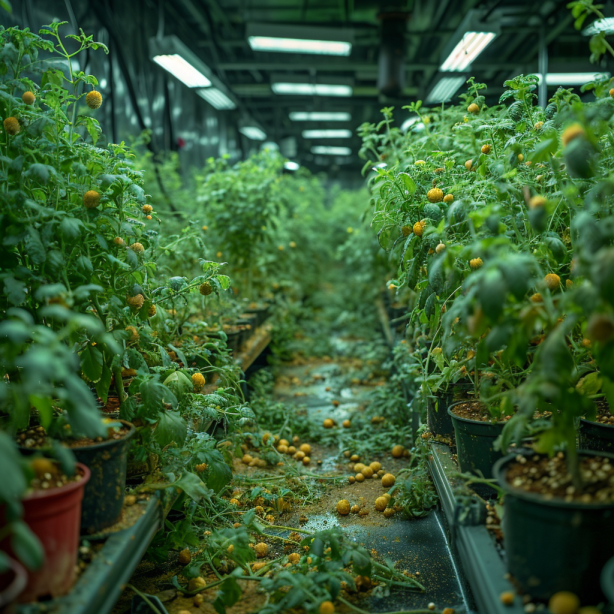
For healthy plants, add nutrients according to manufacturer guidelines, typically every 1-2 weeks in reservoirs.
Monitor EC/pH and replenish as needed.
Flush systems completely every 2-4 weeks to prevent salt buildup.
More often with fast-growing plants.
Flushing Techniques
- Water-only flush: Drain and replace nutrient solution with plain pH water for 24 hours.
- Repeat water-only flush but replace with 1/4 strength nutrients after draining.
- Deepwater Flush (DWF): Fill reservoir higher than normal level for 1 day.
- Recirculating Flush (RDF): Use plain water in a loop for 1 day, slowly dripping through system.
- Flush with hydrogen peroxide to oxygenate roots and kill pathogens.
- Mild vinegar flush to dissolve salts. Rinse thoroughly after.
Flushing frequency depends on factors like plant size, temperature, and reservoir size.
Larger reservoirs may not need as frequent flushing.
Monitor plant health and flush promptly at the first signs of issues like yellowing leaves or mineral deposits.
Consistent reservoir maintenance keeps hydroponic systems thriving.
Understanding Nutrient Burn
Excessive nutrients damage plants through salt buildup and disrupted uptake of other elements.
Initially, leaf tips and margins get “burnt.” Prolonged overfeeding stunts roots, inhibits flowering, and can eventually kill plants.
Long-Term Effects
Over time, toxicity stresses plants, reducing vigor and yields.
Flowers and buds deteriorate in quality and flavor.
Recurring toxicity compromises root function and limits nutrient absorption.
Fixing and Preventing Nutrient Burn
- Fix mild cases by flushing the system, removing damaged foliage, and resuming at lower nutrient levels.
- Prevent issues by starting seeds/clones with quarter-strength nutrients and gradually increasing.
- Mix concentrates meticulously and test EC/pH frequently. Target optimal ranges.
- Choose quality nutrients suited to each plant’s needs and growth stage.
- Flush systems regularly to avoid salt accumulation.
Additional Hydroponic Challenges
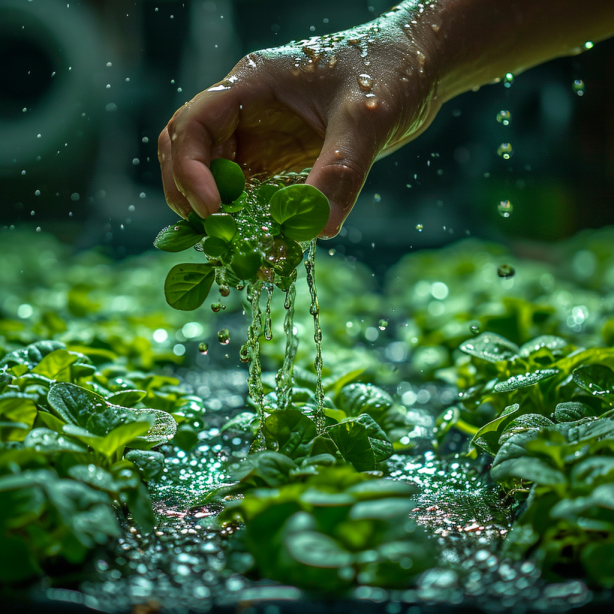
Hydroponics demands diligent monitoring to maintain ideal conditions. Common problems include:
- Water quality issues – poor pH, pathogens, minerals
- Nutrient deficiencies if certain elements are lacking
- Incorrect pH affecting availability of nutrients
- Excessive total dissolved solids (TDS/EC)
- Light, temperature or humidity stress
- Leaks causing flooding, pump failures
- Clogged nozzles or air stones
- Unsuitable growing media composition
- Improper positioning under lights or in reservoirs
Staying attentive and quickly addressing any changes prevents small issues from escalating.
Consistency is key for hydroponic success.
Nutrient Burn in Different Growing Mediums
In soil, excess fertilizer damages roots and inhibits nutrient uptake.
Flush soil thoroughly and let plants dry out between waterings.
Amend soil to improve drainage.
In hydroponics, overfed roots suffocate in concentrated solutions.
Drain and replace the reservoir with plain pH water.
Gradually reintroduce nutrients at lower levels once roots recover.
For both, prune damaged foliage to prevent progression.
Start young plants on mild nutrient doses and increase gradually.
Avoid overapplying concentrated fertilizers.
Hydroponic Nutrient Solutions Guide
Nutrient solutions provide optimal ratios of essential elements for growth.
Major nutrients needed in large amounts: nitrogen, phosphorus, potassium, calcium, magnesium, sulfur.
Secondary nutrients: iron, chlorine, manganese, zinc, boron, molybdenum, copper.
Micronutrients are beneficial in small doses: nickel, sodium, cobalt, selenium, silicon, vanadium.
Premix concentrates per instructions using clean, dechlorinated water.
Check pH and EC frequently.
Change reservoirs and flush systems every 2 weeks.
Start seedlings on quarter-strength solutions and increase levels for mature plants.
Avoid direct contact between concentrates and roots.
With balanced nutrition and attentive care, hydroponic gardens flourish.
Maintaining Optimal Conditions
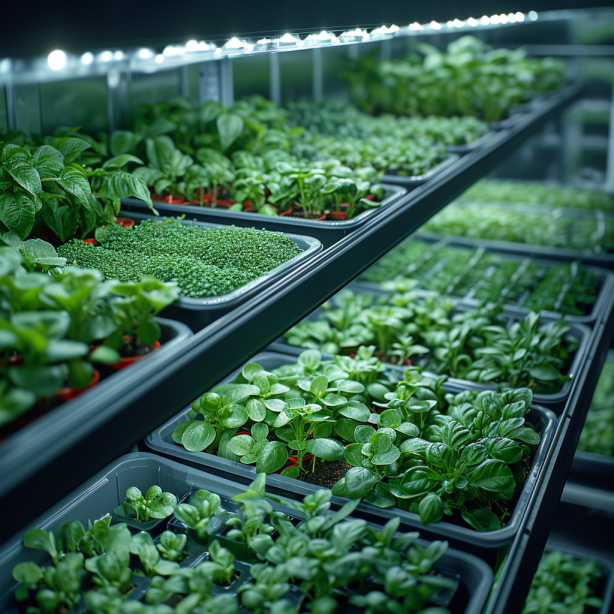
Many factors influence ideal feeding frequency and strength in hydroponics.
Consider aspects like:
- Plant variety and growth stage – Seedlings, vegetative growth, or flowering/fruiting
- Environment – Temperature, humidity, light levels
- Reservoir size – Smaller volumes need more frequent replenishment
- System type – Faster drainage in NFT vs deep water culture
- Plants per system – More plants consume nutrients faster
- Growth rate – Faster growing plants need more nutrients
Interpret feeding schedules as general guidelines.
Closely monitor plant health and appearance.
Increase nutrient strength or frequency if plants show deficiencies.
Decrease if you notice toxicity signs.
Finding the optimal balance takes attentive observation and care.
Aim to maintain nutrient levels in the ideal range specific to each plant variety and growth phase.
Test EC and pH routinely to inform your adjustments.
Consistency is key, but stay flexible in responding to plant needs.
With experience, you will learn how to keep your hydroponic environment at peak conditions.
Frequently Asked Questions
What are the essential nutrients for plant growth?
Plants need certain essential nutrients to grow properly.
The main essential plant nutrients are nitrogen, phosphorus, potassium, calcium, magnesium, and sulfur.
Other essential nutrients include iron, boron, chlorine, manganese, zinc, copper, molybdenum and nickel.
What are the symptoms of nutrient deficiency and toxicity?
Plants show symptoms when they are lacking certain nutrients or have too much of certain nutrients.
Common signs of nutrient deficiency include nutrient burn, chlorosis or yellowing/browning of leaves.
Spotting and prevention of nutrient deficiencies and toxicities is important for optimal plant growth.
Can using too much nutrients in hydroponics solution cause problems?
Yes, adding excessive amounts of nutrients to the hydroponics solution can potentially lead to nutrient toxicity.
Maintaining the proper electrical conductivity and keeping nutrient levels within recommended ranges is important for healthy plant growth.
Excess nutrients can cause nutrient burn on leaves, stunt growth, reduce yields and even kill plants.
How do I know if my hydroponic garden has a nutrient deficiency or toxicity?
There are some common signs to look for that can help identify nutrient deficiencies and toxicities.
Deficiency symptoms include leaf discoloration like chlorosis while toxicity may cause leaf tip burn or scorching.
Checking plant growth, water quality factors like pH levels, and symptoms…
… against a guide can help determine if adjustments to the hydroponics system or nutrient quantities are needed.
What are some easy steps to manage nutrients in my hydroponics system?
There are a few simple things growers can do to manage nutrients properly.
Regularly test the water quality factors like ph and EC using a TDS meter.
Maintain fresh nutrient solution and replace it periodically according to the plant’s stage of growth.
Drain and clean the reservoir when noticing deficiency or toxicity symptoms.
Adjust PH levels if needed and follow the recommended nutrient amounts listed on the general hydroponics bottles.
How often should I add nutrients to my hydroponic solution?
The frequency of adding nutrients depends on the type of hydroponics system and size of the reservoir.
As a general guideline, nutrient solution in most Deep Water Culture (DWC) or Ebb and Flow systems…
… should be replaced every 1-2 weeks while nutrient film technique (NFT) systems may need replacement as often as weekly.
The amount added should follow the recommendations on the nutrient bottles/packets or an established feeding schedule.
Should I adjust nutrients for different plant types?
Yes, nutrient requirements can vary depending on the type of plant being grown hydroponically.
Leafy greens like lettuce need fewer nutrients than flowering plants or fruits/veggies.
It’s a good idea to understand each plant’s ideal nutrient ranges for optimal growth.
Following generalized hydroponic nutrient schedules is a good starting point…
… but the amounts may need adjusting based on the individual crop’s needs and growth stage.
What nutrients are especially important for hydroponic leafy greens?
For fast growing leafy greens in hydroponics, nitrate-N and potassium are among the most important macronutrients.
Maintaining adequate yet not excessive levels of these nutrients is key to producing dark green, lush leaves.
The water temperature and oxygen levels in systems like deep water culture are also important considerations for healthy leafy greens.
Choosing fast-growing varieties and providing optimum growing conditions helps maximize yields.
How can I tell if a hydroponically grown plant needs more or less nutrients?
There are a few signs to watch out for that indicate a plant’s nutrient needs.
Pale or yellowing older leaves could mean the plant needs more nitrogen.
Leaf tips or edges that appear burnt or dried out may signal toxicity from excess nutrients.
Checking growth rate, leaf color (should be dark green), and comparing to guidelines can help assess nutrient levels.
Using a TDS meter to monitor electrical conductivity (EC) in the water also gives clues about nutrient levels in the root zone.
Adjusting fertilizer amounts up or down based on need helps keep plants within their optimal nutrient range.
What is the recommended nutrient level for hydroponic plants during different growth stages?
Proper nutrient levels vary depending on the plant’s stage of growth.
Seedlings and clones need weaker nutrient solutions around 500-700 ppm.
Vegetative growth sees levels increased to 900-1200 ppm to support leafy growth.
Flowering/fruiting plants benefit from moderate to high nutrient solution around 1200-1500 ppm.
Nutrient needs are highest at this stage.
During ripening, levels should be lowered again to 900-1200 ppm to avoid affecting quality.
Monitoring electrical conductivity and following feeding schedules tailored to growth stages helps deliver nutrients effectively.
Conclusion
Balancing nutrient levels is a nuanced art in hydroponics.
While plants need adequate nutrition, overfeeding causes significant issues.
Stay attentive to early signs of toxicity like burnt leaf tips.
Test EC and pH routinely to monitor changes.
Start young plants on mild solutions and increase strength gradually.
Flush systems periodically to prevent salt buildup.
With careful control of nutrients tailored to each variety and growth stage, hydroponic gardens can thrive productively.
Consistent maintenance and prompt adjustments are key.
For optimal harvests without burn, stick to the mantra – monitor, modulate, and flush.
Let us know your best practices for fertilizing hydroponically in the comments!
References
- https://floraflex.com/default/blog/post/symptoms-of-nutrient-deficiency-and-toxicity-in-hydroponics
- https://www.ctahr.hawaii.edu/oc/freepubs/pdf/scm-10.pdf
Related Articles
- https://tophydroponicgarden.com/hydroponic-mistakes-troubleshooting/
- https://tophydroponicgarden.com/hydroponics-for-beginners/
- https://tophydroponicgarden.com/nutrients/
Was this helpful?

I’m Barrie L., a passionate hydroponic gardening enthusiast dedicated to cultivating thriving, soil-less gardens. With a focus on all things hydroponic, I share my expertise on innovative growing techniques and sustainable practices through my blog, tophydroponicgarden.com. As a seasoned hydroponics specialist, my goal is to inspire and guide fellow gardeners in harnessing the power of water-based cultivation for bountiful and eco-friendly harvests. I’m also an author of the book “Hydroponics For Absolute Beginners: Your Step By Step Guide For How To Create An Hydroponics System At Home Without Soil, For Growing Vegetable, Fruit And Herbs.” which is sold on Amazon. Join me on a journey of redefining the way we cultivate plants, one nutrient-rich solution at a time. Happy growing!

